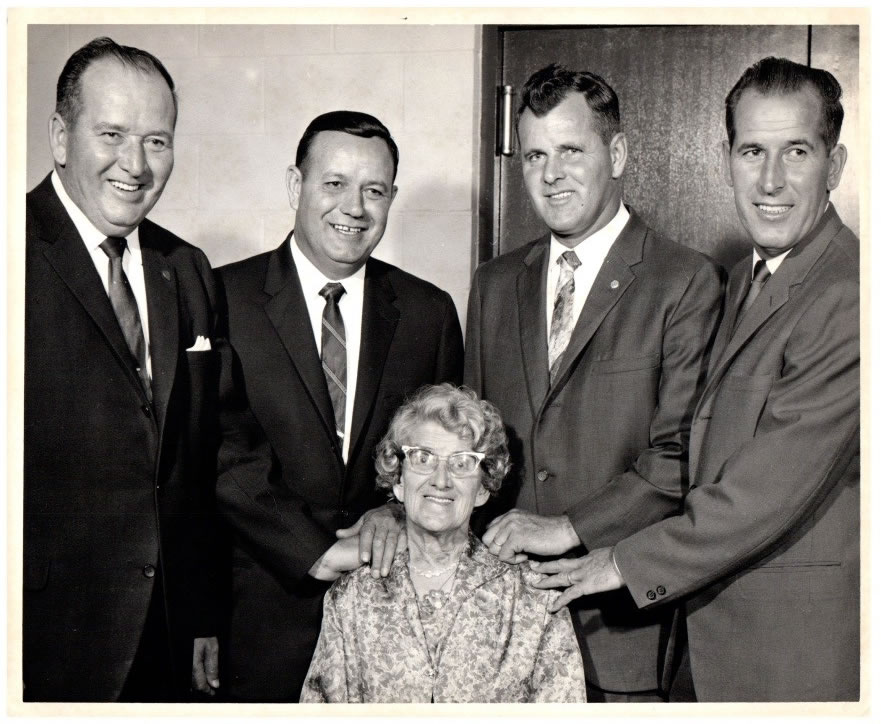History
The tale of the four Dubreuil brothers is one that would surprise the most enterprising individual. As young men, Napoléon, Joachim, Augustin, and Marcel all worked for their father in a small family business, building doors, windows and frames. Following the death of their father in 1945, the Dubreuil brothers decided to enter into the sawmill business; and with $1,000 in equity the famous partnership, Dubreuil Brothers Ltd. was established. In 1947, the brothers left Taschereau, Québec and ventured to Ontario to earn a living.
While working as a small lumber harvesting contractor in Northern Ontario, the Dubreuil brothers were successful in obtaining lot concessions from the Algoma Central Railway (ACR) in 1951. With this new contract they recruited approximately thirty men from the Taschereau region, built two sawmills and nearly thirty homes. The small town of Magpie was born some 18 kms from the current town of Dubreuilville.
In 1958, Augustin Dubreuil invented the “Sputnik” (fondly named after the first Russian Satellite to be launched into space in 1957), a piece of equipment that was capable of bringing full length logs into the sawmill by a single operator. The “Sputnik” revolutionized the sawmill industry and was adopted by many other sawmills in Canada, the United States and Sweden. The process of bringing “full tree lengths” to the sawmill was a North American industry first. The Dubreuil Brothers were indoctrinated into the Lumber Hall of fame for having pioneered this process and changed how modern day logging is performed all over North America.
|
From Left to Right: Napoléon Dubreuil, Joachim Dubreuil, Augustin Dubreuil and Marcel Dubreuil. Centred is their mother Cecil Dubreuil. |
In 1961, the Dubreuil brothers obtained additional cutting rights twenty-three kilometres north-east of the Magpie town site and decided to relocate the entire community. Consequently, Dubreuilville was created when roughly 200 people were moved from the Magpie town site to the new Dubreuilville location along the shore of the Magpie River. Additional homes were built while several were transported from the existing site to the new location. In 1962, the road, now known as highway 519, connecting Dubreuilville to the Trans-Canada highway 17 was constructed and funded by the Dubreuil Brothers. From 1961 – 1977, Dubreuilville was considered an unincorporated municipality which made a private company site. Historically, Dubreuilville was a company town; there was no need for money to buy the items on your grocery list, employees only were required to provide their badge numbers to cashiers at the local grocery store to make purchases; tabs and journal entries would be recorded and then deducted monthly from employee pay cheques. Dubreuilville was a gated town; vehicles had to check-in at the gate located at the turnoff at highway 17 and highway 519 in order to make sure the road was free of oncoming transport trucks who used CB radios to announce their journey as they travelled down the 32km road to travel between the trans-Canada highway and the town site. Caution was always top of mind. Hence, if you did not have a valid reason to visit Dubreuilville, you would be denied access. The Dubreuil Brothers sold off all of the homes and residences to their employees in 1978 in order to allow for the creation of a registered provincial Township recognized by the province of Ontario. This enabled the newly elected mayor and council to apply for government subsidies to build much needed municipal infrastructures such as a new school, arena, medical clinic, water and waste water facilities that met provincial standards. The Dubreuil Brothers sawmill was sold to one of the four brothers children; Jean-Paul Dubreuil who ran an operated the sawmill from 1988 to 1989 after which he had to sell it to Ken Buchanan and James River Paper due to fiber access disputes and production limitations. The Buchan and/James River partnership renamed the sawmill operations Dubreuil Forest Products and operated the facility until November 2008 after which it closed its doors due to harsh economic times and depressed lumber prices. The cyclical nature of the lumber industry is always very challenging for single industry towns such as Dubreuilville. |
Dubreuilville has benefited from other industries over the years, namely the mining industry and the tourism industry. Both have thrived at different times. The Gold mining industry is currently being spearheaded by Alamos Gold Island Gold mine site which is located 18 kms from the town of Dubreuilville. The mine produces more than 100,000 ounces of gold per year and is one of the top performers in the industry. Approximately 1/3 of the mine’s workforce is from Dubreuilville while others miners travel to the mine site to perform shift work. The mine has established bunkhouses facilities within the town of Dubreuilville’s boundaries in addition to occupying several homes, apartments and special buildings to house their workforce. There are several other mining companies operating in the area, namely Argonaut/Prodigy Gold, Manitou Gold and Trillium Mining who are all performing different stages of exploration work.
Dubreuilville has always benefited from a strong tourism industry, it is especially known for its winter snowmobile trails as several Ontario Federation of Snowmobile Club TOP trails intersect in Dubreuilville. One can travel to Hornepayne and Hearst to the North, or travel East to the small town of Missanabie and to the West to the towns of White River and Marathon or to the South and reach Hawk Junction, Wawa and Sault Ste Marie and Chapleau. The large volume of trail assets due to historical logging road construction over Crown Land make the Dubreuilville’s trail networks its pride and joy.





